|
The majority of people living in Greater Jakarta use motorcycles and cars for daily commutes to and from work, causing severe traffic jams in the capital city during rush hours. The economic loss due to chronic congestion in Jakarta is estimated to be around IDR 65 trillion, or USD 4.8 billion, per year (equivalent to 3.3% of Jakarta’s GDP in 2015), well above the cost of the entire MRT project (IDR 58.0 trillion, or USD 4.3 billion). |
|
In an attempt to ease traffic in the capital city, the government has begun the first phase of its MRT and LRT projects, targeting completion in 2019 (accounting for 20.5% of the entire planned network). However, these initial MRT and LRT lines are not expected to significantly reduce Jakarta’s traffic, as the rail network will remain inadequate to motivate large numbers of daily commuters to switch from private vehicles to rail mass transportation. The positive effect of the MRT/LRT system in reducing traffic should be felt only when the entire planned network is completed in 2024-27 as the system covers more densely populated areas across Jakarta. The government is highly optimistic that it can finish the initial-stage development on time; land acquisition issues have been partly mitigated, despite challenges in funding. |
|
Daily Influx of Private Vehicles Causes Severe Traffic Jams in Central and South Jakarta Jakarta is the largest megacity in Southeast Asia, with a 100% urbanisation rate as of 2015, almost twice that of the whole country (54.0%). With a population of 10.2 million people (4.0% of the total population in Indonesia) and a land area of 664.0 square kilometres (sqkm) as of 2015 (0.03% of the total land area in the country), Jakarta’s population density ratio is 15,328 people per square kilometre. This is at least ten times higher than other regions in Indonesia and double that of Singapore, Bangkok, and Kuala Lumpur/KL. Nevertheless, Jakarta is the only city in Asia with no rail-based mass rapid transit (MRT) system. Its ASEAN peers have implemented MRT systems each more than a decade ago: Singapore in 1987, Kuala Lumpur in 1995, and Bangkok in 2004. Of the one million commuters who lived in Jakarta in 2014 (10.4% of the population above age 5), 72.8% commuted daily between their homes and their destinations (offices/educational institutions, etc.) using private vehicles; public transport’s share was low at 24.3%. Most Jakartans opt for private vehicles due to the lack of reliable public transport. Rising per capita income and wide availability of vehicle financing have made motorcycles and cars affordable to Jakartans (private vehicle penetration rate in 2014: 160%). Consequently, the number of registered motorcycles and cars have grown faster than the road network (CAGR of 11.2% vs. around 1% during the same period over 2009-14). Making matters worse, 68.4% of the 1.4 million commuters living in the capital’s four neighbouring cities (Bodetabek – Bogor, Depok, Tangerang, and Bekasi) also make daily roundtrips by private vehicle, as most government offices, corporate headquarters, and well-known educational institutions are located in the capital city. Due to such commuter inflow from the periphery, Jakarta’s population usually increases by around 1 million people (up by 10.0%) during the daytime. Traffic is especially heavy towards Central and South Jakarta, as 55.8% of the 2.4 million commuters that live in Greater Jakarta (Jabodetabek – Jakarta, Bogor, Depok, Tangerang, and Bekasi) either work or study there. The average speed for cars has been reported to be as low as 15.3 km/hour (h) during peak hours, almost half the average speeds in Singapore (28.9 km/h), and London (26.6 km/h). This is despite Jakarta having currently the world’s longest bus rapid transits (BRT) system (210.0 km in length), with capacity to transport up to 280,000 passengers per day through 12 corridors (12.0% of commuters in Jakarta). A 2004 study by Japan International Cooperation Agency (JICA) estimated that Jakarta will face a total gridlock by 2020 if the city does not improve its urban transportation system. |
Jakarta’s Population Density Twice that of Peers, 2016
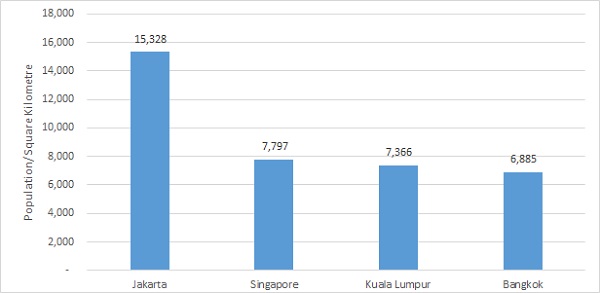 Source: Official government statistics
Note: Figure for Jakarta is as of 2015 |
Majority of People in Jabodetabek Use Private Vehicles to Commute (Motorcycles and Cars), 2014
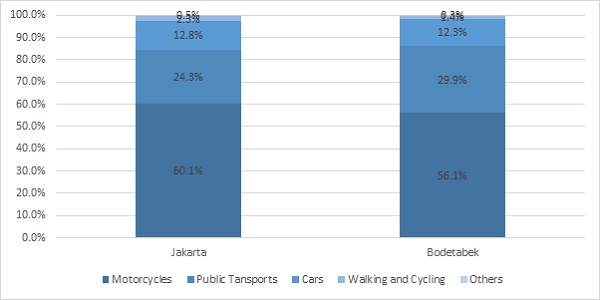 Source: Statistics Indonesia
Greater Jakarta covers Jakarta and its four neighbouring cities (Bodetabek – Bogor, Depok, Tangerang, and Bekasi) |
Majority of People in Jabodetabek Commute to Work Daily, 2014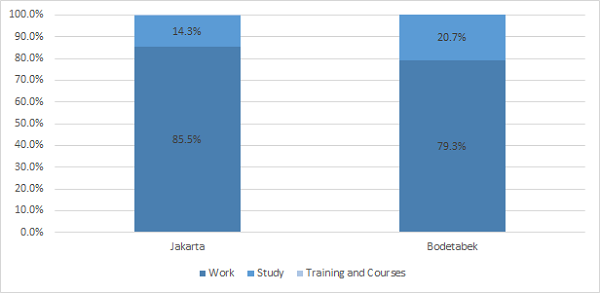 Source: Statistics Indonesia
Greater Jakarta covers Jakarta and its four neighbouring cities (Bodetabek – Bogor, Depok, Tangerang, and Bekasi) |
Around Half of Commuters in Jakarta Are from Neighbouring Cities, 2014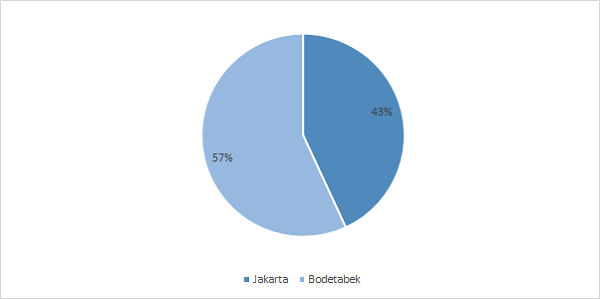 Source: Statistics Indonesia
Note: Jabodetabek comprises Jakarta and its four neighbouring cities (Bogor, Depok, Tangerang, and Bekasi – also known as Bodetabek); Jabodetabek is widely known as Greater Jakarta |
Heavy Commuter Traffic to Central and South Jakarta Causes Severe Traffic Jams, 2014 Source: Statistics Indonesia |
|
MRT and LRT Lines a Possible Solution to Heavy Traffic In order to overcome Jakarta’s traffic jams, the government is planning to construct an MRT system with a total track length of 117.3 km by 2024-27 (37.9% of the entire MRT and LRT network), terminating at more than 60 stations across Jakarta. The MRT system in Jakarta will involve the construction of East-West (87 km) and North-South (30.3 km) corridors. While the East-West line is still under pre-feasibility study, the construction of the first phase of the North-South line began in October 2013, connecting the densely populated residential area in Lebak Bulus (South Jakarta) to the CBD area (Central Jakarta), where prime offices, five-star hotels, and well-known shopping centres are located. The overall progress of the first phase was 76.0% as of August 2017; it is scheduled to open to the public by March 2019. Once completed, the first phase of the North-South line (15.7 km; 13.4% of the MRT’s total length) will have the capacity to transport around 433,000 passengers per day (18.0% of commuters) and reduce travel time significantly to within 30 minutes, from around two hours by car during rush hours. The second phase (14.6 km; 12.4% of the MRT’s total length), which will begin construction in late 2018, will stretch the network further from Central Jakarta to Ancol in North Jakarta. It is not expected to be operational until sometime in 2021. The entire MRT system will be integrated with the existing commuter railways, BRT system, and the future LRT system in Jakarta. The government of Jakarta also plans to incorporate seven corridors of light rail transit (LRT), widely known as LRT Jakarta, to criss-cross the MRT network. These intra-city LRT lines will have seven corridors and a total track length of 107.7 km once completed (34.0% of the entire MRT and LRT network). The first phase of corridor one (5.8 km, or 5.3% of the Jakarta LRT line, from Kelapa Gading in North Jakarta to the Velodrome sports complex in Rawamangun – East Jakarta) has been under construction since June 2016, with the overall completion rate at 35.0% as of September 2017. It will be used to transport athletes for the upcoming Asian Games in August 2018. In order to reduce private vehicle influx from cities neighbouring Jakarta, the central government will also develop the LRT system that connects the capital city with Bodetabek. This LRT system, widely known as LRT Greater Jakarta or LRT Jabodebek, will have a total track length of 83.6 km upon completion (28.1% of the total network). The entire project will be constructed in two phases:
To ensure seamless public transportation services in Jakarta, the network of LRT Jabodebek will also be integrated with LRT Jakarta and MRT Jakarta. |
|
Government Resorts to Consignment to Expedite Land Acquisition for First Phase of North-South Line Project; Further Funding Needed for Replacing Steel Structure Land acquisition for the North-South line of the MRT project has been in progress for around five years since it began in 2012. Hundreds of landowners have already been given monetary compensation for giving up their land as of December 2016. However, six residents in Cipete and Fatmawati in South Jakarta have refused to hand over their land, and instead have filed a civil suit against the Jakarta government for higher compensation (court trial started in March 2016). Due to the long procurement process, the Badan Pertanahan Nasional/BPN (National Land Agency) resorted to consignment (based on article 43 of Law no. 2/2012), notifying landowners via letter of the termination of their legal ownership of the plots; the law supports land acquisition in favour of public interest. This process transfers land ownership to the state even though the legal process for settling the land payment is ongoing (there is no update yet on whether the residents have given up their lands). Aside from the land acquisition issue, the MRT project is also hampered by funding problems due to the need for an additional IDR 2.6 trillion, or USD 191.0 million, (around 5% of the original budget) to replace the existing steel construction with a structure that is in line with the new, 2013 standards for earthquake resistance. The initial budget was based on 2002 standards, which require fewer components. |
|
Funding Issues Key Bottleneck in Phase One of LRT Projects While land acquisition should not be an issue for the first phase of corridor one of the LRT Jakarta project (as the route will be constructed on the existing road), funding remains a challenge. In April 2017, PT Jakarta Propertindo (state-owned project owner and operator) stated that IDR 2.1 trillion is still needed from the Jakarta government (33.0% of the total cost). Financing the project through bank loans is not an attractive option, given high interest rates (the four biggest banks currently offer corporate loans with interest rates of around 9.75%-10.5% per annum). PT Jakarta Propertindo has therefore requested the Jakarta government for more capital. As for LRT Jabodebek, the project’s first phase will be constructed on both state-owned land and privately owned land. While the state-owned land can be used entirely for the project, the government still needs to acquire five hectares of land that belongs to private owners in East Bekasi, to be used as an LRT depot. The Ministry of Transportation stated that the process of acquiring privately owned land is already in the final phase and should be completed by September 2017 (no updated news on whether the government has succeeded in this). In terms of funding, however, the government still needs to raise IDR 5.6 trillion more in equity (20.4% of the total cost) from the state budget in order to increase PT Kereta Api Indonesia’s (state-owned project owner and operator) total equity to IDR 9.0 trillion (32.7% of the total cost), so that it can secure IDR 18.5 trillion of financing from state lenders and other financial institutions (67.3% of the total cost). |
|
Lessons Learnt from Bangkok and Singapore: Well-Integrated Public Transport System and High Cost of Vehicle Ownership Can Encourage Switching from Private Vehicles to Public Transport In order to determine whether the future development of Jakarta’s MRT and LRT systems will help ease traffic congestion in the capital city, we looked at the current state of urban transportation system in Bangkok and Singapore, specifically into how it has impacted private vehicle use in each respective city or country. We selected Bangkok, as its congestion level is the closest to Indonesia’s (average speeds during rush hour in Bangkok and Jakarta are 18.5 km/h and 15.3 km/h respectively). Singapore provides a good benchmark for the average speed that Jakarta could expect to achieve if it improves its urban transportation system (arterial roads: 28.9 km/h; expressways: 64.1 km/h). Despite having MRT and BTS SkyTrain systems for more than a decade, Bangkok continues to experience heavy traffic congestion, as private vehicle ownership has remained high, dominating transport. This can be attributed to lack of MRT/BTS coverage in Bangkok, as well as to limited interconnectivity between the existing rail network with other public transportation modes such as buses. A well-integrated public transport system is crucial for ensuring first-mile and last-mile connectivity. Bangkok’s rail mass transit system has somehow failed to attract a large number of people to switch from private vehicles to MRT/BTS; private vehicle ownership continued to increase at an accelerated rate (9.2% YoY in 2013 vs. 3.2% YoY in 2010), causing more traffic and lowering the average speed. Although Bangkok has a much larger population and land area than Singapore, its rail network lags behind Singapore’s, with a much lower rail network density (Bangkok: 10.1 km/million people; Singapore: 35.6 km/million people). The majority of MRT and BTS SkyTrain users are people who do not own private vehicles and are therefore used to commuting via different types of public transportation such as buses and ferries. Market shares of buses and ferries fell during 2011-13 as MRT and BTS SkyTrain ridership increased. Hence, the positive impact of the rail transit system in reducing traffic congestion is minimal at the current density level. The government is planning to improve its density ratio to 47.0 km/million people by expanding the existing network by almost five times in 2029 from the current length of 111.0 km (20.7% of the total planned rail network in 2029). In the more mature market of Singapore, rail network density and scheduled/fixed-route bus penetration have remained high, resulting in high usage of public transport. Singapore’s growing population and increased rail length and bus fleet have boosted ridership on MRT/LRT and buses to 50.5% and 68.6% of the total population in 2014, respectively. Its well-integrated public transport system provides an alternative mode of transport to private vehicle users, while prohibitive car prices act as a deterrent to vehicle ownership. Growth in private vehicles has decelerated in Singapore since 2007, falling an average of 2.6% during 2013-16. This can be attributed to the higher connectivity that Singapore’s public transport system provides and the high cost of vehicle ownership (including the cost of cars, vehicle registration fees, certificates of entitlement/COE, electronic road pricing/ERP, and parking fees). Although travel time is longer in public transport, current trends in Singapore show that people have nevertheless been giving up their vehicles for the cheaper alternative of public transport. |
|
Private Vehicles Dominate Transport in Bangkok and Jakarta; Public Transport Dominates in Singapore
 Source: Compiled by UZABASE based on various sources
Note: Data for Bangkok is as of 2014 and does not provide information on other mode of transport. Data for Indonesia and Singapore is as of 2010 |
Low Rail Mass Transportation Penetration and High Private Vehicle Ownership in Bangkok and Jakarta; Vice Versa for Singapore Source: Compiled by UZABASE based on various sources
Note: Data for vehicle penetration and rail network density is as of 2014 and 2016 respectively. Data for bus penetration is different for each country: Jakarta (2016), Singapore (2014), and Bangkok (2011)
Note: Private vehicles comprise motorcycles and passenger cars |
Bangkok – Private Vehicle Ownership Accelerates; Switch to Public Transport Low, Further Lowering Average Speed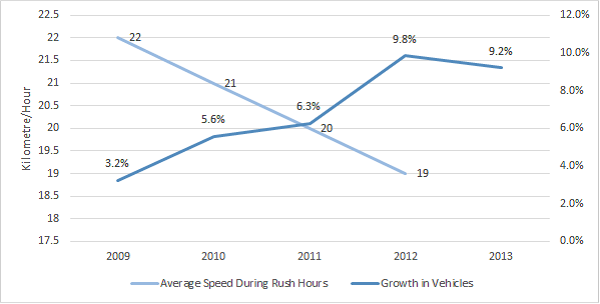 Source: Compiled by UZABASE based on various sources
Note: Private vehicles comprise motorcycles and passenger cars |
Bangkok – Public Transport Users Switch to Mass Rail Transport from Buses/Ferries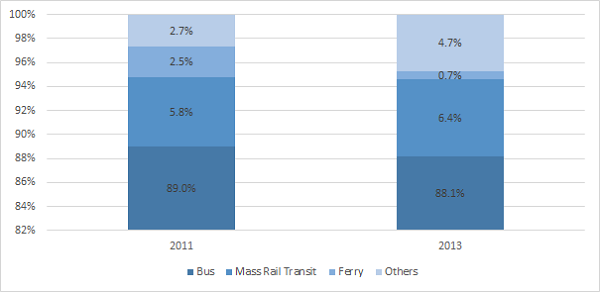 Source: BTS Holdings’ Annual Report |
Singapore – Public Transport Network Expands over 2006-16; Private Vehicle Ownership Decelerates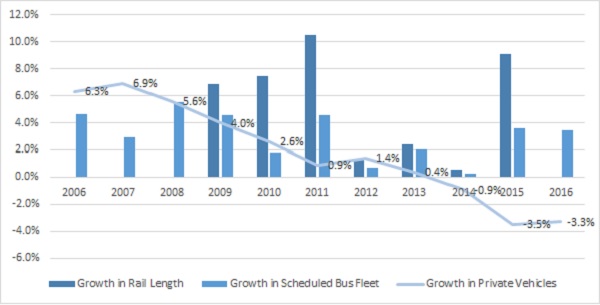 Source: Land Transport Authority Singapore
Note: Private vehicles comprise motorcycles and passenger cars |
|
Traffic to Improve Only after 2027, When Entire MRT and LRT Network Is Completed Assuming that all under-construction projects will be completed successfully by the end of 2019, Jakarta would have a total track length of 63.6 km, with a rail network density of a mere 5.7 km/million people, around half of Bangkok’s (10.1 km/million people) and around six times lower than Singapore’s (35.6 km/million people). Similar to Bangkok’s, Jakarta’s rail connectivity might be inadequate to attract a large number of people to switch from private vehicles to rail mass transportation. At this initial stage, motorcycles and cars will remain the only mode of transport for a majority of Jakartans to connect to destinations beyond the coverage of MRT/LRT lines. Only those people who live and work around the vicinity of the MRT/LRT stations might be willing to trade-off their vehicles for rail mass transport. Otherwise, the majority of rail transit users would be switching from other modes of public transport as rail mass transit provide a more reliable alternative to the traditional public transport such as mini buses, public vans, three wheelers etc, which accounted for around 30% of the transport modes in Jakarta in 2010. Once all the under-construction projects are completed by 2019, they will have the capacity to transport up to 900,000 passengers per day (excluding Jakarta LRT’s capacity, due to limited data), accounting for 37.8% of commuters in Jakarta. Further, assuming that the entire MRT and LRT network can be completed by 2027, rail network density in Jakarta should improve significantly to 25.4 km/million people as the total track length expands fivefold to 310.0 km, covering more densely populated areas across Jakarta. However, the density ratio will remain 28.6% below the current level in Singapore. This is not to mention that in order to make an apple-to-apple comparison, we also need to assume that by 2027, the Jakarta government would have expanded its scheduled bus network, improved its parking management system and built a highly integrated public transportation system just like in Singapore, in addition to making private vehicle ownership more expensive in Jakarta. The government is currently planning to implement electronic road pricing (ERP) to complement the MRT and LRT systems in reducing traffic, but this may take some time to due to regulatory preparation, the equipment bidding process, and infrastructure development. Nevertheless, once the entire MRT and LRT network is completed, we estimate it will have the capacity to transport all commuters in Jakarta (North-South line of MRT project and Greater Jakarta LRT combined already have the capacity to transport up to 1.8 million passengers per day, or 78.0% of commuters in Jakarta). With increased capacity and connectivity across the North-South and East-West corridors, more private vehicle users will have the option of using MRT/LRT to reach places beyond the vicinity of their homes and workplaces and to pass through areas with heavy traffic such as those in Central and South Jakarta. Based on population growth of 1% over 2014-27, we forecast that commuters who use private vehicles in Central and South Jakarta will increase to 1.1 million people by 2027E from 952 thousand people in 2014. Assuming that 20.0% of the 1.1 million commuters decide to use the MRT/LRT, the total number of commuters who use private vehicles in Central and South Jakarta will decline gradually to 911 thousand people after the completion of the MRT/LRT in 2027E, a level that is lower than the current number of commuters in Central and South Jakarta (952 thousand people in 2014 vs. 911 thousand people in 2027E). Accordingly, traffic congestion in these two particular areas should improve. With shorter travel time, mobility will increase in Jakarta, allowing faster economic growth in the city. |
Rail Network to Remain Inadequate by 2019, with Overall Completion Rate Below a Third of Total Planned Rail Length Source: Compiled by UZABASE based on various sources |
Jakarta Rail Network Density to Improve Significantly by 2027, but Remain Below Current Level in Singapore Source: Compiled by UZABASE based on various sources |
Population in Greater Jakarta Forecasted to Increase 1% Annually until 2027 Source: Compiled by UZABASE based on various sources; forecasts computed by UZABASE
Note: During 1990-2000, Jakarta experienced suburbanisation; growth was therefore slower than previously |
Commuters Using Private Vehicles to Decline Gradually after Full Implementation of MRT and LRT Systems in 2027 Source: Statistics Indonesia; forecasts computed by UZABASE
Note: Private vehicles comprise motorcycles and passenger cars |
|
APPENDIX: Jakarta Plans to Complete Rail Mass Transit Network by 2024-27 Source: Compiled by UZABASE based on various sources |
MRT North-South Line – First Phase to Be Completed by 2019 Source: Compiled by UZABASE based on various sources |
Jakarta LRT Corridor One – First Phase to Be Completed Before Asian Games 2018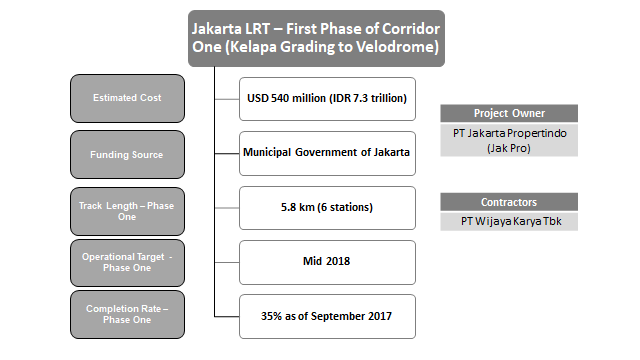 Source: Compiled by UZABASE based on various sources |
LRT Jabodebek Development – First Phase to Be Completed by 2019 Source: Compiled by UZABASE based on various sources |
Greater Jakarta Urban Railway Network Map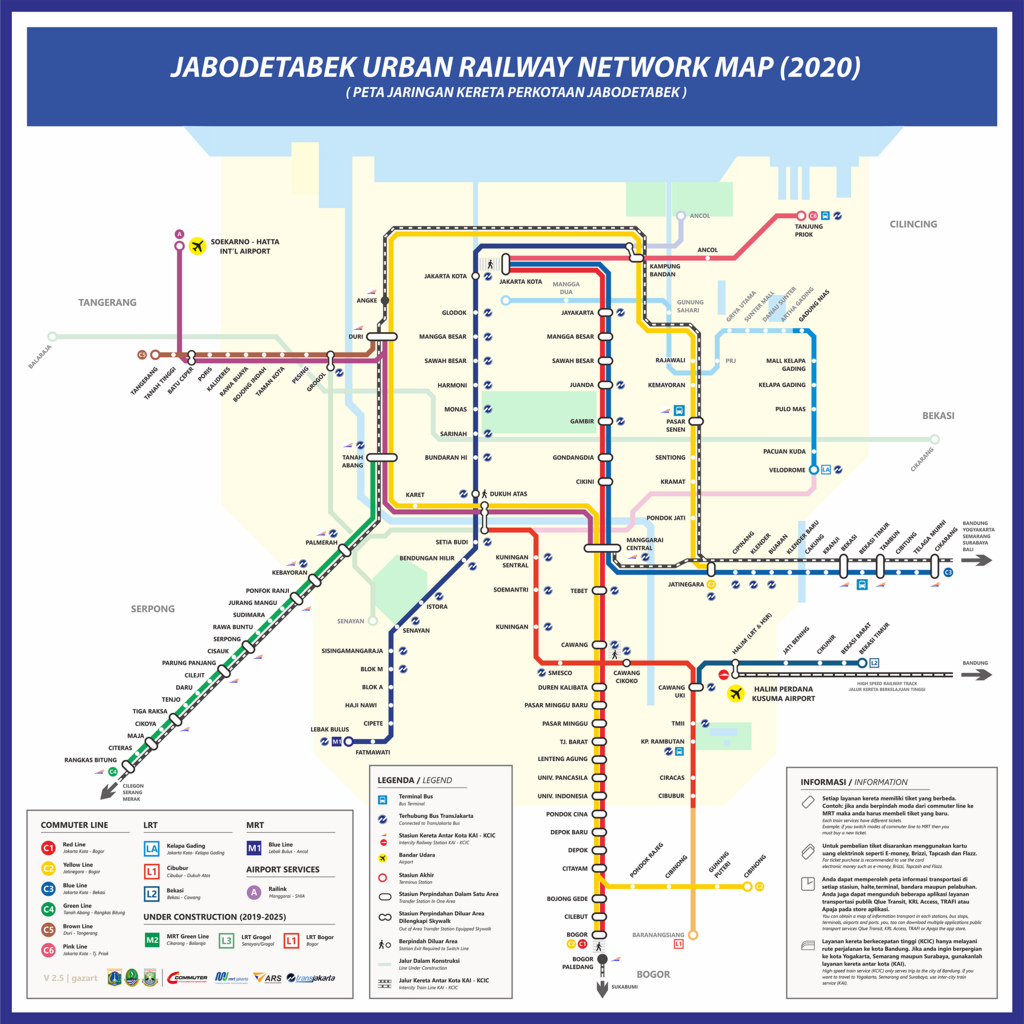 Source: flickr.com |



